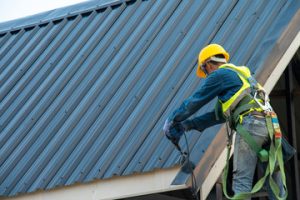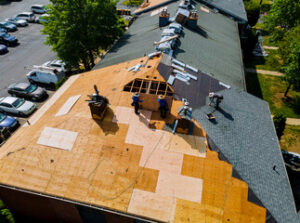Erie Metal Roofing is becoming increasingly popular for residential homes. Whether you are a home owner, architect, builder or distributor, it is important to understand the pros and cons of each metal roof type.
Steel is the most common metal roof material. It can be either galvanized or coated in a layer of aluminum. This helps prevent corrosion.
1. Durability

When it comes to weather resistance, metal roofs have the edge over traditional shingles and other materials. They can endure winds with gusts up to 140 miles per hour without breaking, rusting or corroding. This durability makes them a strong choice for homes in regions prone to intense storms or frequent hailstorms, as well as areas that experience heavy snowfall and ice damming.
The durability of metal roofs also helps reduce the amount of maintenance needed over time. As a result, homeowners can save on repair and replacement costs. In addition, the roof’s lifespan is typically longer than that of other roofing products.
Durability is not only related to the material used in a metal roofing system, but also to its thickness and how it’s installed. Involving experienced professionals for installation ensures that all aspects of the project adhere to strict industry standards, ensuring that the roof can withstand environmental conditions over time.
Steel, galvanized steel, and aluminum are the most popular options for residential metal roofing due to their durability and longevity. Galvalume, which uses a combination of aluminum and zinc, is even more resistant to corrosion.
Corrosion resistance is also important to consider for coastal communities, where salt air can deteriorate certain types of metal roofing. If your home is near the ocean, or in a humid environment, choosing copper or zinc as a metal roofing material may be a smarter choice.
One of the best ways to maximize your metal roof’s durability is by performing regular maintenance. This includes cleaning debris from gutters and drainpipes, checking for damage and repairing any minor issues promptly. It’s also a good idea to install a protective metal roof paint finish, which will shield the metal from environmental conditions and accelerate the life of your roof.
2. Energy Efficiency
A metal roof is not just a durable and effective roofing system, it also has the potential to significantly lower energy bills. This is because metal roofs have a high reflective factor, which helps to minimize heat absorption and keep buildings cooler. This can greatly reduce reliance on air conditioning, which is often a major contributor to higher energy bills during the warmer months.
The energy efficiency of a metal roof is further boosted by its thermal emittance, which describes how efficiently it releases absorbed heat. Depending on color and finish, some roofs are better at this than others, which is why it’s important to take your aesthetic preferences and environmental requirements into account when selecting the ideal roofing solution for your home or business.
Aside from the color you choose, there are a variety of textures that can be applied to a metal roof. These provide different visual effects and can complement a variety of architectural styles. For instance, a modern-style home might benefit from a smooth metal finish, while a hillside cottage can look stunning with a textured surface.
Energy efficiency isn’t just about your roof; it’s about your entire building and how it operates. For example, the insulation in your walls and the type of appliances you use can influence how much electricity is used for heating and cooling. Metal roofs can help you reduce your carbon footprint and save money on energy bills at the same time, while helping to combat the so-called “heat island effect” in urban areas. Moreover, the fact that metal is recyclable means it can contribute to sustainability goals while providing a sleek and stylish look.
3. Aesthetics
Metal roofing is available in a wide range of colors, textures, and panel profiles to complement any architectural style. Its versatile aesthetics enhance the look of homes and buildings, bolstering their curb appeal and overall value.
From timeless matte black to bright white, metal roofs offer a vibrant color palette. The shade you choose will depend on several factors, including the architectural style of your home and its surrounding landscape. Lighter shades reflect sunlight, which can help reduce cooling costs during hotter weather. Additionally, if your neighborhood has homeowners’ association (HOA) rules or regulations that dictate the exterior color palette, be sure to comply.
Corrugated metal roofing, for example, accentuates modern architectural styles with its minimalist aesthetic. Its textured panels also resist the wavy distortion known as “oil canning,” which affects flat areas of conventional shingle roofs. A textured panel design is an excellent choice for log cabins and other rustic structures, as it accentuates their natural beauty.
For homeowners seeking the classic aesthetic of traditional roofing materials, metal shingles can be designed to replicate the appearance of terra cotta tiles or wood shakes. These roofs allow homeowners to preserve the historical integrity of their property while enjoying the durability and low maintenance benefits of metal roofing.
Textured metal panels also resist scuffing and scratching, which can otherwise mar the sleek look of their counterparts. Additionally, textured metal panels are less prone to oil canning than their non-textured counterparts, which makes them a great option for farm and residential structures.
4. Low Maintenance
Unlike other roofing materials that require constant attention, metal roofs don’t deteriorate or become damaged by the elements. This helps homeowners save time and money while also protecting their investment. Despite their longevity, however, it is still important to keep up with the basics of maintenance and inspection.
A metal roof’s durability is based on its ability to resist extreme weather conditions such as high winds, hail, and heavy snowfall. It also needs to be able to stand up against the elements like rust, mildew, and algae. This means that it needs to be properly prepared for these environmental factors and should have protective coatings or treatments applied as needed.
Performing regular maintenance and inspections can help prevent common metal roof problems like leaks, loose screws, scratches, and dents. It can also help detect a potential problem like a broken panel seam or rusted fasteners and allow for timely repairs.
Leaks can be caused by corrosion or punctures from objects like debris, nails, or tree limbs that hit the roof. Regularly inspect the gutters to ensure they are clean and clog-free. It is also a good idea to trim back any branches that hang over the roof to avoid damage from falling debris during high wind or rainy weather.
In addition, it is important to regularly inspect and clean any drains, vents, or pipes that penetrate the roof to make sure they are free from blockages and damage. Also, any screw holes should be checked to ensure they are not backed out from expansion and contraction of the metal. If they are, it is recommended that the screws be replaced by a professional to avoid any further damage to the panels or seams.
5. Recyclability
Metal roofs are 100% recyclable, which makes them an ideal choice for environmentally conscious construction projects. Considering that metal roofing lasts much longer than traditional roofing materials, it requires fewer replacements and less waste over the lifetime of the building, which can make a major difference to a facility’s sustainability profile. Additionally, many modern metal roofs are designed with eco-friendly coatings that minimize environmental impact.
These durable roofs are also a great option for building owners who want to conserve water resources. They are compatible with rainwater harvesting systems, which allow homeowners to collect and reuse rainfall for landscaping or other non-potable uses. These water-saving systems reduce the strain on municipal water supplies and help to minimize the need for additional resources.
In addition, a metal roof’s long lifespan means that it will be recycled frequently. Unlike asphalt shingles, which require replacement every 15 to 30 years, a metal roof can last 50 or more years, meaning that the material will be recycled several times over its lifetime. This recycling process will also help to preserve natural resources, and the energy required to recycle a single aluminum beverage can saves enough electricity to power a 100-watt light bulb for 3.5 hours.
Moreover, metal roofs can be made from recycled materials, such as steel or copper. This reduces the energy needed to mine new raw materials, which helps to lower a facility’s carbon footprint. Furthermore, the insulation backing and coating residues used on these roofing products can be recycled into Refuse-Derived Fuel (RDF) through specialized shredding equipment, helping to improve a project’s sustainability profile even further.


